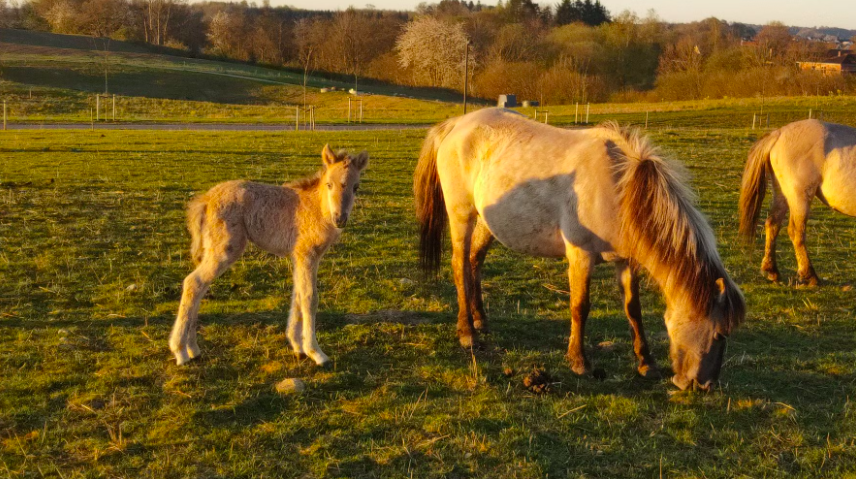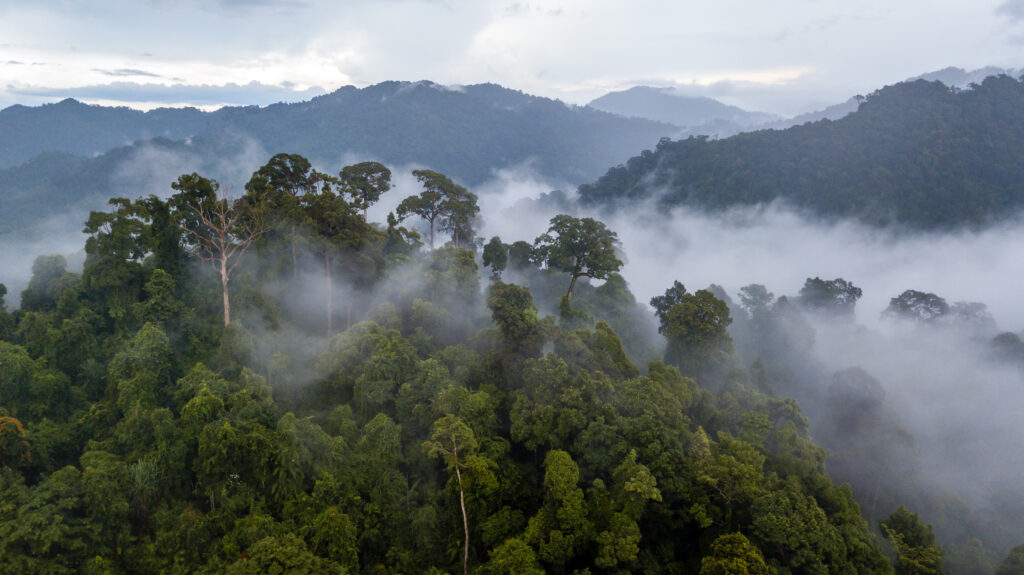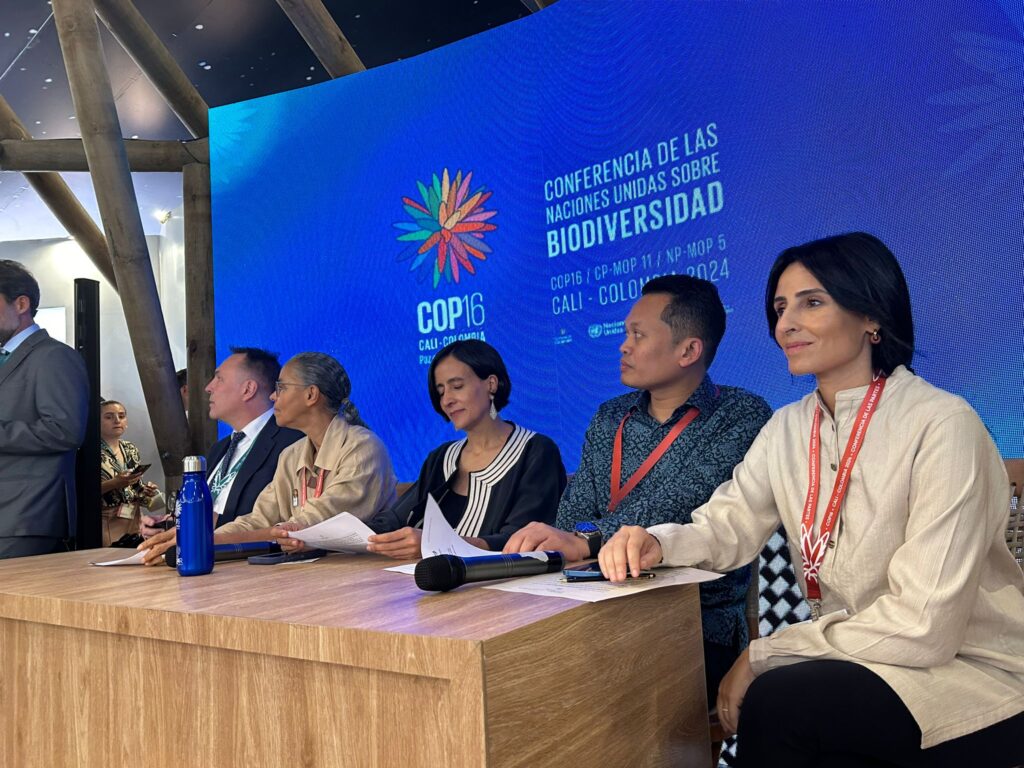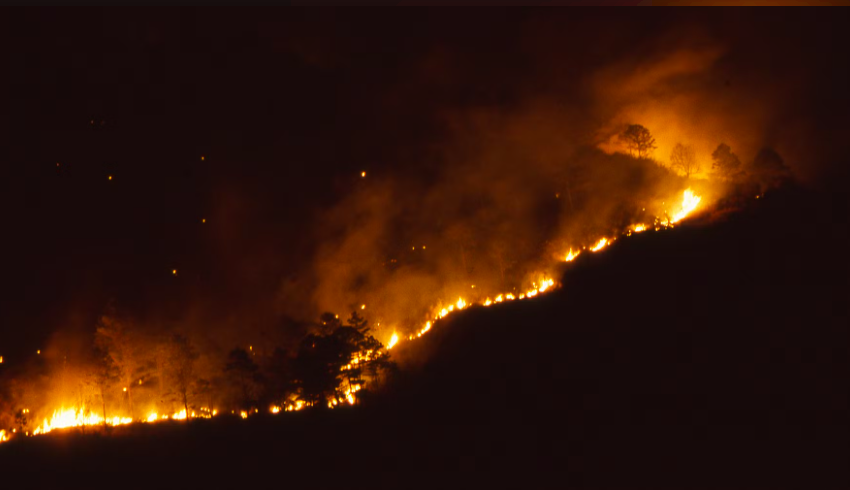This brings the total number of foals born this year to two. Their presence has already had a positive “rewilding” effect on the 17 hectares of land the horses graze, improving the area’s natural condition.
The horses in Tirsbæk Bakker are of the Konik breed, which originates from Poland, and they are wild. With the two new foals, the small herd now consists of seven horses in total: one stallion, three breeding mares, a filly from last year, and the two new foals from this year. Earlier in the year, the herd was split up due to limited space, with a young stallion and two young mares being sent to North Jutland. The plan is for Forests of the World to collaborate with other partners breeding the same breed, facilitating exchanges to avoid inbreeding. Additionally, another young stallion has been moved to the other side of Vejle Fjord, to Store Helvedeshul – a kettle hole on the edge of Sønderskoven – where it grazes alongside another young stallion. The goal is to eventually find a larger natural area where more stallions can live together as they are naturally driven out of the herd and used for breeding elsewhere.
As the horses graze overgrown areas, they create space for other, rarer plant species, which in turn fosters a more varied and rich ecosystem. For example, the small herb marsh marigold, which grows in wet meadows, has started to bloom with plenty of yellow “buttercups.”
Rewilding near an Urban Area
The horses are part of the “rewilding” concept, which involves managing nature by mimicking its own processes. Danish nature is particularly lacking large grazers that can help maintain wetlands, meadows, heathlands, and pastures by preventing overgrowth and thus avoiding a uniform natural environment. The principle behind “rewilding” is to reintroduce key animal species that are essential for maintaining the ecological balance, allowing ecosystems to develop on their own with as little care and human interference as possible. Therefore, the horses in Tirsbæk Bakker are a good example of how nature, if left alone, can stabilize itself, providing space for a wide variety of plant and animal species.
Horses are particularly good at extensive grazing because they move across the area throughout the day, creating small openings in the vegetation as they tread holes in the ground. This allows plants like perennials and herbs to sprout, and more types of insects can thrive. Additionally, in winter, they graze on all sorts of vegetation, including small trees, bushes, and even brambles, which helps create a more open vegetation structure where many different types of plants can thrive.
Part of rewilding is that the animals should be as wild as possible and take care of themselves. When you walk in Tirsbæk Bakker, the idea is to enjoy seeing the horses from a distance and to avoid touching or feeding them. Although the horses may look a bit thin at this time of year, this is perfectly natural because they are wild horses. The horses lose weight in the winter due to a scarcity of food, relying on the fat they have built up over the summer and autumn. When the horses become hungry, they start eating small trees, rushes, and bramble thickets that would otherwise spread across open landscapes. As Jens Holm Kanstrup, biologist at Forests of the World, explains:
“This is the whole idea of having them out all year round. In summer, there is plenty of food, so the herbaceous vegetation is allowed to grow. In winter and early spring, when there is no more grass, the horses start grazing on the vegetation that grew during summer and autumn, which benefits the herbaceous plants that require light and space. At this point, the food supply for the horses is already sufficient, so they can gain weight again after the winter’s shortage of grass. Our horses have followed the natural cycle perfectly, and the rewilding has gone exactly according to plan in the first year.”
According to Jens Kanstrup, it wasn’t until early spring that some of the horses showed signs of slimming down, as the vegetation had been grazed down to the ground. To ease the concerns of local residents, hay was provided for the horses. However, the horses have hardly touched the hay, instead preferring to eat raspberries.
“This is a positive sign and another indication that they are thriving in their environment and prefer to eat the natural food available in the area. As much as possible, Forests of the World will avoid supplementary feeding, as it reduces the positive impact of year-round grazing and would also introduce nutrients that we would prefer to avoid. If a three-month ice winter or other extreme weather conditions occur, they will naturally be fed when necessary,” says Jens Kanstrup.
According to Jens Kanstrup, it’s important not to have too many horses in one area. The ideal is 2-3 hectares per adult horse, and that’s why Forests of the World, in collaboration with Vejle Municipality, is also looking into expanding the area to ensure there is enough space for all the horses when the foals grow up strong and healthy.
Although the project at Tirsbæk Bakker takes place in a limited, urban-adjacent area, it’s an experiment showing that rewilding can succeed. Rewilding simply requires a nudge in the right direction, such as the reintroduction of large grazers, and, above all, that humans don’t interfere too much or engage in intensive production on the land.
Read more about what Forests of the World believes we can do to increase wild nature and biodiversity in Denmark.
Press Contact
Jonas Schmidt Hansen
Who is Forests of the World?
We work to preserve the world’s forests, both in Denmark and the world’s tropical forests.Our focus areas include sustainability, Indigenous Peoples and local engagement.




